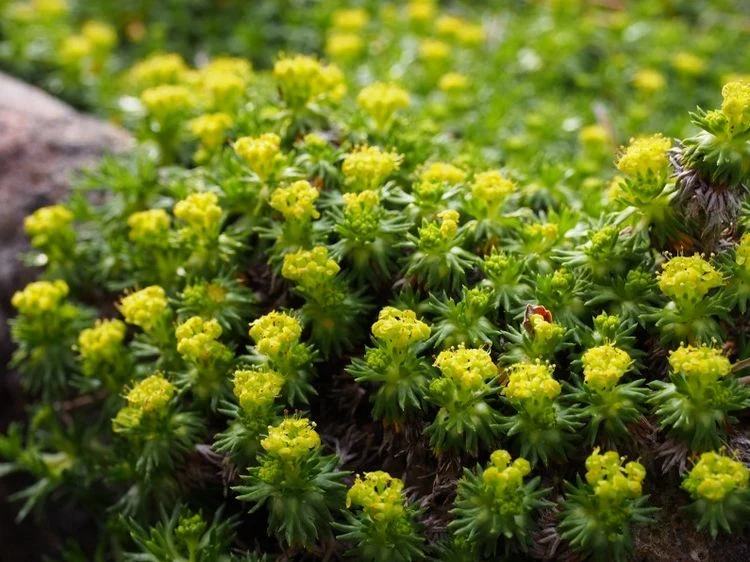Are you looking for fast-growing, hardy ground covers to fill in the bare spots in your garden? With these undemanding plants, you can complement any flower bed and underplant any tree.
Groundcovers are very useful in the garden as they add visual interest, keep weeds away and cover the ground very nicely. They’re a low-maintenance landscaping option, but you probably don’t want to wait months for them to grow to achieve the look you want. Find out here which hardy ground covers you can plant in late summer and autumn, which are also fast-growing and undemanding.
Hardy Ground Covers: These 8 Fast-Growing Plants
Hardy groundcovers look amazing planting the ground between shrubs and flowers. They are often used in the home garden as a practical solution to weed control and to prevent soil erosion. These 8 low-growing plants will add gentle, natural beauty to your garden and don’t require much maintenance to grow vigorously.
Fast growing carpet sedum
The carpet sedum is a great ground cover for any garden. It grows very vigorously and can spread over a meter in one season. It thrives in poor soil and tolerates heat very well even without watering. Its bright green foliage remains attractive even through the cooler autumn and winter months. Carpet sedum blooms from late spring to early summer with tiny yellow flowers that attract pollinators. The best time to plant this hardy groundcover in the garden is in spring or autumn, but you can also plant early plants in summer.
Wild thyme for the garden
Wild Thyme is an evergreen, fast-spreading plant that is suitable as a lawn replacement and ground cover. The low-growing perennial is hardy and relatively undemanding. Although it prefers well-drained soil, it also thrives in lesser soil, in spots with full sun to part shade. Despite its enticing scent, wild thyme is deer resistant. The flowering ground cover plant is very attractive to bees, however, making it a lovely addition to honey bee-focused gardens. Wild thyme can be sown directly in the garden in late spring or in tubs in summer.
Ivy is an evergreen groundcover
Ivy is a fast-growing, evergreen that makes a popular groundcover despite its invasive properties. It does best in a shady spot and is drought tolerant. The ivy takes root in many places and its stems spread over a large area. Therefore, be aware that its dense growth in the bed can overgrow other plants and thinning may be necessary. But don’t forget that it offers shelter to birds and wildlife all year round.
Beautiful bluebells
Bluebells are an excellent groundcover that blooms in lilac, violet, blue and white from June to September. Its flowers are rich in pollen and nectar and very attractive to bees and other pollinating insects. So that they can take root well, it is advisable to plant them from spring to early autumn.
Small periwinkle
The small periwinkle offers many advantages as a ground cover. It is undemanding and tolerates drought, sun and shade. It grows fast and strong and spreads out to fill in the bare patches very nicely.
The smooth, dark green leaves and beautiful blue or purple flowers add a dense, lush look to your garden. It can be planted in the garden all year round, although the best time is from March to October.
Hardy groundcover: deadnettle
Deadnettle is the perfect groundcover plant, much appreciated for its pretty flowers in summer and evergreen foliage.
They can be planted in a cool, shady spot in spring or fall. Since it grows quickly, you should keep a minimum distance of 40 cm when planting.
The dead nettle is very undemanding and requires almost no maintenance. No pruning is required, although oversized plants can be pruned back in the spring if desired.
Ordinary soapwort
This great herb is very easy to grow in the garden. It can grow up to 90 cm high and since it self-seeds easily, it can be used as a ground cover in suitable places. This plant typically grows in colonies and blooms in pink and white from mid-summer through fall. Its lightly scented blooms often attract butterflies. The optimal time for planting in the garden is from spring to autumn.
Himalaya-Storchschnabel
The Himalayan Cranesbill is a compact, perennial ground cover plant that produces blue-purple blooms from early summer to early fall. It spreads very nicely among other plants in the garden and its main advantage is that it is not infested by rabbits, snails and slugs. It thrives in all soils and although it is relatively easy to care for, it does not tolerate waterlogging. It is recommended to place between 4 and 12 plants per square meter to ensure a dense soil cover quickly.
